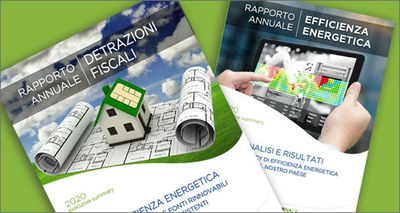Italy: ENEA, €3.5 billion invested in energy-efficiency interventions in 2019, €42 billion since 2007
29/10/2020
 Over €42 billion invested in energy requalification interventions, of which €3.5 billion in 2019 alone, with an overall saving of approximately 17,700 GWh / year, of which slightly over 1,250 GWh / year in 2019. This is the economic assessment of 13 years of eco-bonus, a mechanism to incentivize energy efficiency in end uses introduced in 2007.
Over €42 billion invested in energy requalification interventions, of which €3.5 billion in 2019 alone, with an overall saving of approximately 17,700 GWh / year, of which slightly over 1,250 GWh / year in 2019. This is the economic assessment of 13 years of eco-bonus, a mechanism to incentivize energy efficiency in end uses introduced in 2007.
Furthermore, thanks to this tax deduction and other incentives, in 2019 250 million euros were saved in the national energy bill and over 2.9 million tons in CO2 emissions.
These are the main data contained in the 9th "Annual Report on Energy Efficiency" and the 11th "Annual Report on tax deductions for energy saving measures and use of renewable energy sources in existing buildings", by ENEA, presented in a webinar attended by, among others, the Minister for Economic Development, Stefano Patuanelli, the Undersecretary to the Presidency of the Council of Ministers, Riccardo Fraccaro, the CEO of the GSE, Roberto Moneta, and the President of ENEA, Federico Testa.
The two reports show very positive results in 2019 also regarding other types of incentives: the thermal account, mainly targeted to energy efficiency and renewables interventions in the PA, showed a 68% increase compared to the period 2013-2018 with 114 thousand total requests and a 29% increase compared to 2018 as for incentives obtained, totalling 433 million euro; white certificates, aimed at promoting energy efficiency in companies, allowed to save over 3.1 Mtoe / year since 2011.
In 2019 the energy saving objective, indicated by the National Action Plan for Energy Efficiency and the National Energy Strategy, was met at 77.2%: at sectoral level, the residential sector has already exceeded the target indicated, 'industry is well over halfway (61.9%), transport has exceeded half (50.4%), while the tertiary sector, including the PA, is less than a third (29, 4%). Energy audits, crucial for optimizing energy efficiency interventions in companies, are among the tools that have made it possible to achieve these results.
In December 2019, approximately 11,200 diagnoses were submitted: if the identified interventions were to be conducted, a total saving of 3.7 Mtoe / year would be obtained, mainly divided into lower electricity (29%), thermal (7%) and fuel ( 30%) consumption.
Federico Testa said. "Expanding the range of action of the interventions will allow to amplify the effects of efficiency and create a national chain of the 'white economy', relaunching strategic sectors such as construction ande production of goods and services", Testa said, "ENEA, also in its capacity as National Energy Efficiency Agency, it is fully committed to this challenge which includes urban regeneration, redevelopment of the most degraded buildings and fight against energy poverty, a new form of poverty and social risk which, unfortunately, concerns an increasing number of families ”, Testa concluded.
In order to estimate energy poverty in Italy, ENEA has adopted a tool inspired by the LIHC (Low Income - High Costs) measure, used by the British government, which has allowed to highlight the significant link between energy poverty and the economic situation of families : energy efficiency policies can also be a concrete solution to the problem, especially as regards the energy efficiency of buildings, a key tool for long-term contrast to the phenomenon and a strategic lever with strong social, economic, environmental and occupational impact.
The figures of the 2019 eco-bonus
The data on the 2019 eco-bonus shows that last year Italian families conducted over 395 thousand energy efficiency interventions, mainly to replace windows (1.3 billion euros), install condensing boilers and heat pumps for winter heating (about 1 billion euros), insulating floors and walls (over 650 million euros), for global redevelopment of buildings (231 million euro) and solar shading (133 million euros). Also in 2019, around 600,000 interventions were conducted with the home bonus (50% deduction) with an overall saving exceeding 840 GWh / year. These interventions are more significant if one considers that in Europe the building stock accounts for about 40% of total energy consumption and 36% of greenhouse gas emissions.
As concerns technological innovation, significant progress has been made in recent years: new buildings tend to consume about half the energy of buildings built at the end of the 90s; however, it is estimated that by 2050, 75% of buildings will still be under-efficient. If the European Union wants to achieve its objectives of carbon neutrality, energy efficiency and renewable sources, the annual renewal rate of the building stock will have to double the current range between 0.4 and 1.2% in several Member States. This paradigm shift intersects with the housing trends post COVID-19, which entail an actual redesign of spaces inside homes and workplaces, in the pursuit of energy efficiency, environmental sustainability, health and well-being .
To download the Energy Efficiency Report (available only in Italian version):
https://www.enea.it/it/seguici/pubblicazioni/edizioni-enea/2020/rapporto-annuale-efficienza-energetica-2020/
To download the Report on tax deductions (available only in Italian version):
https://www.enea.it/it/seguici/pubblicazioni/edizioni-enea/2020/detrazioni-fiscali-rapporto-annuale-2020
